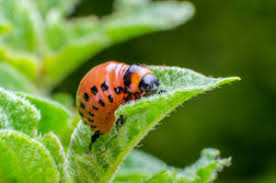Eco-Friendly Pest Control Methods
It’s that time of year again. If you haven’t seen them already, it’s very likely you’re going to start seeing more and more pests trying to invade your garden and home. Fortunately, we’ve got some eco-friendly solutions for you. Rather than using toxic pesticides and harmful chemicals to rid your home of unwanted pests, try one or more of these eco-friendly options first. You and your family will be glad you did.
Plant Your Pest Control in Your Garden
Mint, basil, lavender, rosemary and other herbs work really well as a natural pest control. Planting these in your garden will not only help keep pests away, but these herbs can be used to control pests indoors as well. Herbs are what many consider to be “companion plants” for use in vegetable gardens and throughout the yard. Their purpose is two-fold: attract beneficial insects and deter pests.
If you don’t want to have companion plants in your garden, yet still want to prevent pests from overtaking the yard, try planing some of these: petunias, chrysanthemums, lemongrass, clover, eucalyptus, lavender or marigolds.
Season Your Window Sills
While most people season their food to make it taste better, certain types of seasoning are known to be quite offensive to insects and bugs. Cinnamon, paprika, cayenne, salt, tumeric, black pepper and other seasonings work very well as pest deterrents. Just sprinkle some seasoning in a line along the window sill. Let’s say it’s your way of drawing a line in the sand. You also might want to put some cinnamon, bay leaves or cloves in small bags to place in cupboards, closets, bookshelves or other places around the house where you’ve found pests.

How to Ensure an Earth-Friendly Approach.
- Inspection: A professional pest control expert will discover the pests in your home; their hiding places, cracks, fissures, nooks, and crevices that need to be sanitized and sealed. He will tell you what kind of pests, where they are breeding and where/how they are feeding.
- Source and shatter removal: They will tackle waste, garbage, wet walls, damp wood, cellulose and any other sources of food and for pest.
- Debarring pests: An expert will tell you about the specific spots that are vulnerable to pest infestation. He will show you all the areas/habits/habitats that will attract bugs, termites, mosquitoes, cockroaches, rats or ants.
- A pest control expert will use safe chemicals in safe dosages where most needed. He will keep pets, children, and seniors safe from pesticide nuisance (sensible utilization).
- A final checkup: will ensure a pest-free home.

Green (or Organic) Pest Control
The terms “Green” or “Organic” indicates that the service being acquired is based upon non-chemical measures and the use of naturally happening pesticides. Based upon this point of view, to provide a really “green” pest control service, only those items that come from “earth-based products such as borates, desiccant dusts such as diatomaceous earth and silica, or botanical insecticides and pesticides categorized in classification 25b by the EPA (EPA exempt materials) can be utilized. The EPA does not manage products in Category 25b, which usually include vital oils from plants. While these EPA exempt items may efficiently kill insects on contact, they do have their restrictions and may not deal with relentless insect issues considering that they have little to no residual effect on bugs.
Depending upon your particular bug concern, some popular important oils utilized for house pest control include:

Integrated Pest Management: The Eco-Friendly Approach
Our method eliminates the use of chemical alternatives, an essential step when taking a holistic approach towards pest control. Based on Integrated Pest Management (IPM) programs, our systems rely on comprehensive information about pests and their relationship with the environment.
IPM techniques also look at the relationship between pests and the environment. And while some pests require control, some insects are beneficial. Observing the tendencies of certain pests is essential in identifying the potential problems before engaging in their removal. To move forward in your pest control practices, think about incorporating a few friendly mechanical devices.
Stop! It’s a trap.
While the name itself sounds harmful, traps can effectively and efficiently help in removing your pest population in an eco-friendly way. Pheromone traps track the mating activity of pests by counting the number of insects trapped over time. The traps simulate a scent released by the female insect that will encourage the male counterpart to approach. The traps prevent the pests from mating, reducing population growth.
Be mindful of cracks
Trapping may not always be sufficient in monitoring your pest population. Some pests are easier to target using repellents and insect growth regulators (IGRs). Repellents ward off pests when they come into contact with a substance that damages their exoskeletons. They work best when placed in cracks and gaps around the outside of a home or building. If you’re managing an ant problem, repellents are the way to go. While repellents prevent ants and other small pests from entering your home, IGRs prevent pests from maturing fully and reproducing. This process is key in stopping the growth of your pest population. Keep in mind that IGRs can harm helpful insects like bees, so in order to reduce harm to other insects, focus on areas that are likely to attract fleas, cockroaches, and mosquitos.
Sealing the deal
For a long-term solution, facility maintenance is key. Our environmentally friendly practices prevent and ensure breeding grounds are eliminated through subtle modifications to your home. These practices include cleaning gutters, power washing floors, and sealing potential entryways. Closing off entry ways is a good place to start, but looking inside your home is just as important. Like those sneaky mice, pests are always looking for potential food sources. The most effective way to shoo off unwanted pests is to rid your home or workspace of your leftovers. Be sure to remove any crumbs after eating and eliminate debris in small spaces and hard to reach areas.
Why You Should Embrace Green Pest Management Efforts
When you have to deal with a pest control issue in the home, you don’t want to compound the problem by introducing unsafe chemicals into the air you breathe. This piece of mind for the health and safety of your family is often reason enough to embrace green pest mitigation tactics and products, especially when extreme sensitivities, developing or compromised immune systems are at stake.
In addition to the home, green pest control methods are also popular solutions in kitchen environments, hospitals, hotels, offices and other commercial spaces, in addition to gardens, plants and outdoor areas. Using harsh chemicals to manage pests in such sensitive environments simply isn’t an option!
Some of the chemicals used in the pest management industry can be detrimental to health of anyone or anything that comes into contact with them – this include not only pests, but people as well. And, while the health of inhabitants in treated homes and offices are typically considered a top concern, it’s equally important to consider the safety of those working as pest control technicians; long term exposure to specific chemicals can cause serious damage to the respiratory system and other systems in the body.
Another reason for the growth in green pest management techniques relates to years of heavy reliance on chemical solutions to control pests. Unfortunately, such practices have resulted in unintended consequences, namely pests growing stronger and developing tolerances to specific insecticides, pesticides or poisons. Similar to more resilient microbes, bacteria and viruses, the threat of chemical-resistant pests is rather frightening!